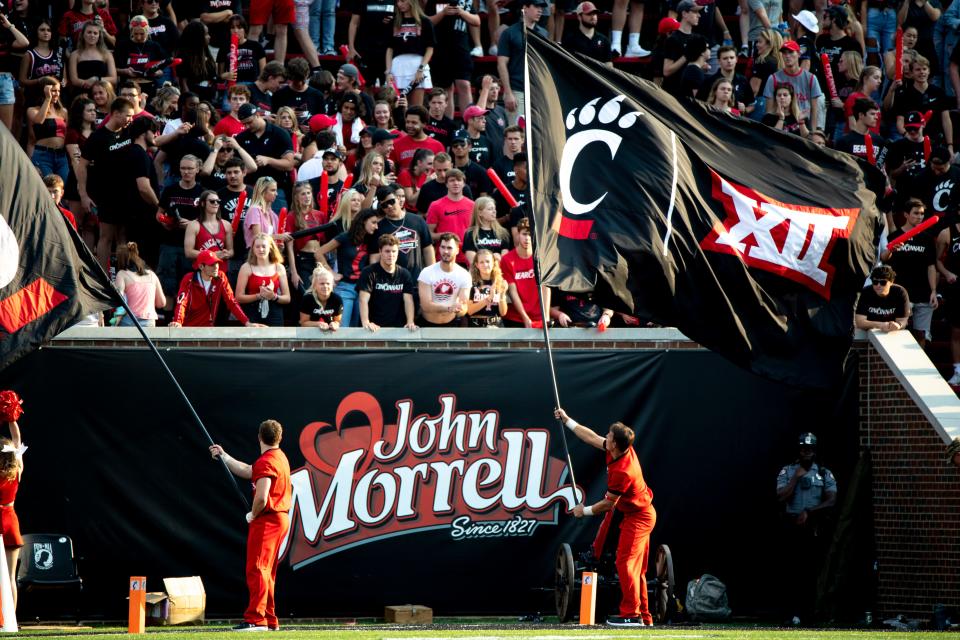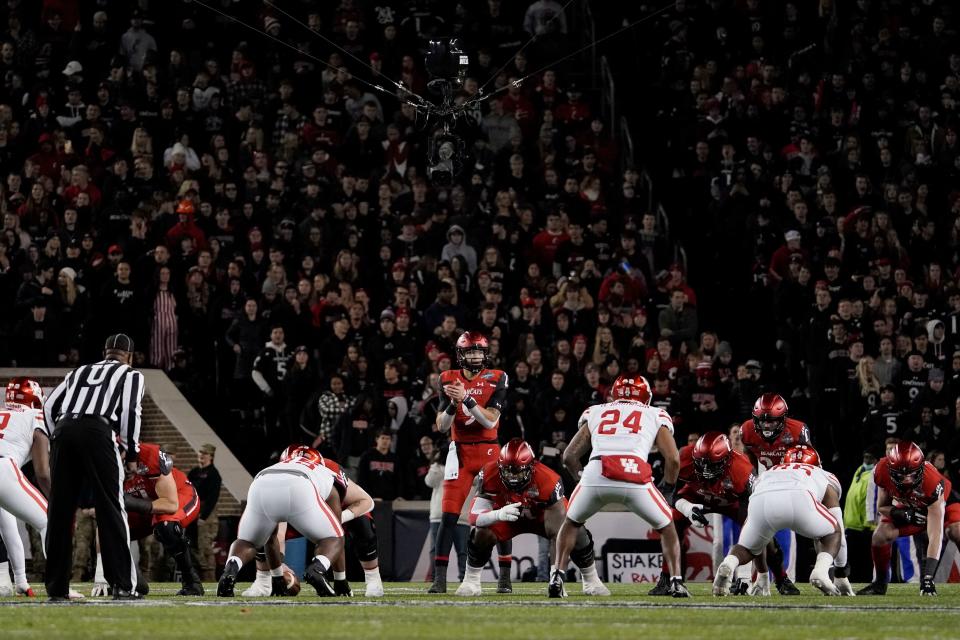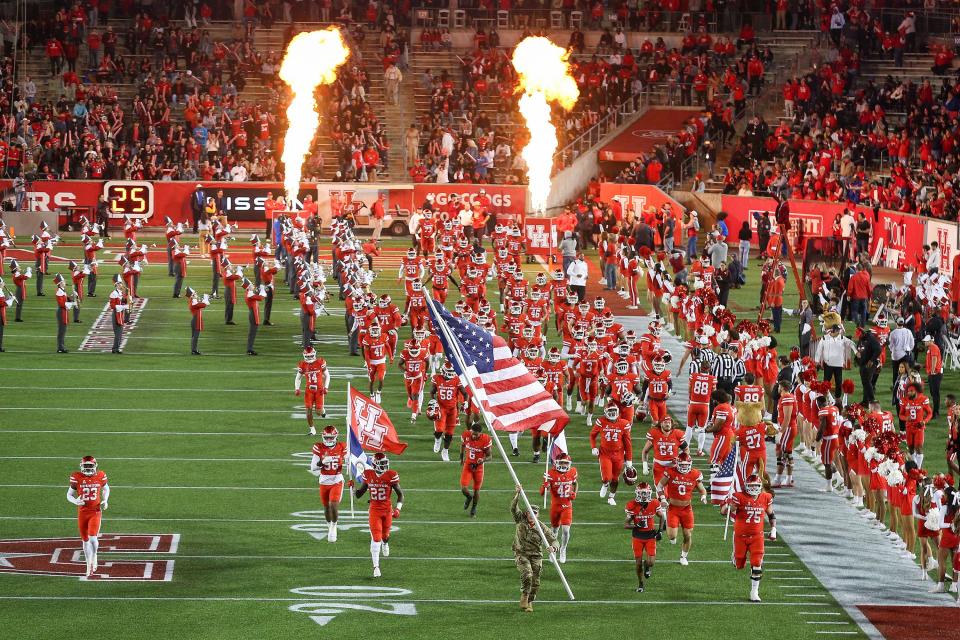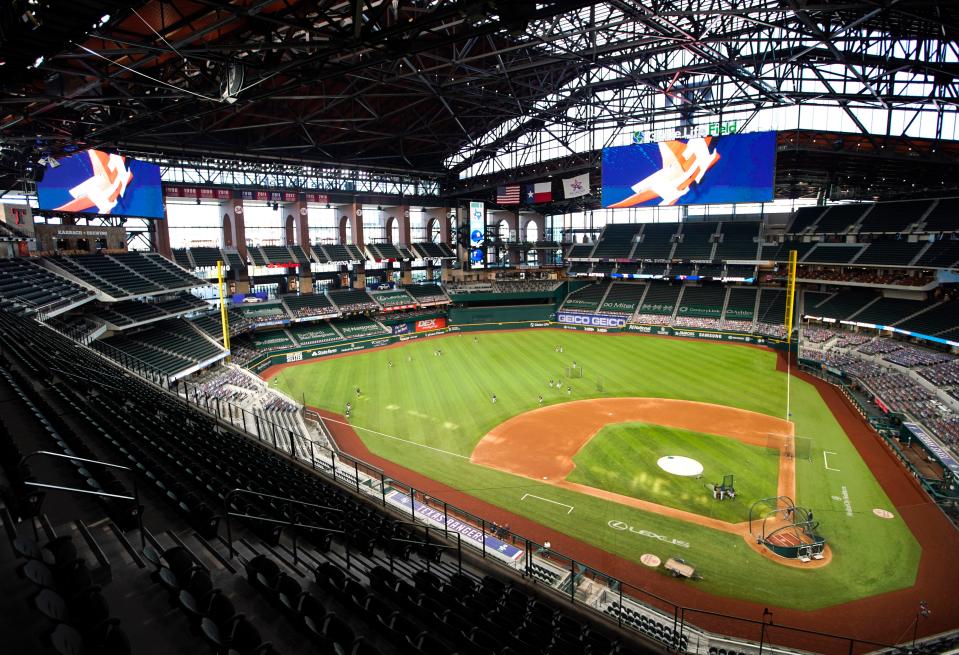Tramel's ScissorTales: Why a Big 12 festival should kick off 2023 college football season
A year ago Thursday, the Big 12 seemed left for dead.
The OU-Texas exodus news broke on July 21, 2021. The Sooners and Longhorns were bound for the Southeastern Conference.
Buzzards circled the Big 12. Within days, its members politicked for landing spots in the Pac-12 (or, much less likely, the Big Ten and Atlantic Coast conferences).
The American Conference publicly recruited Big 12 members. Big 12 commissioner Bob Bowlsby alleged that ESPN sought to “destabilize” the league so that OU and Texas could move sooner, and any conference that picks a fight with ESPN is risking its fiscal future.
The Big 12 in almost every way was a zombie conference.
But a year later, color has returned to faces in Stillwater and Waco, Lubbock and Ames, Lubbock and Manhattan, Fort Worth and Lawrence. The Big 12 has not just a pulse, but a future and maybe even a higher status, though it absolutely faces financial hardships going forward.
More:Why new Big 12 commissioner Brett Yormark is an 'absolute perfect fit' to follow Bob Bowlsby

But the additions of Brigham Young, Cincinnati, Houston and Central Florida have stabilized the league. Meanwhile, the Pac-12 is reeling with the soon departures of Southern Cal and UCLA. The Big 12 actively is recruiting Pac-12 members. And the ACC is stuck with an ESPN contract that goes 14 more years.
In 400 days, the 2023 college football season opens, and a new-look Big 12 launches. OU and Texas figure to be in the conference in 2023 and perhaps 2024, also.
The Sooners and Longhorns still provide a financial bonanza for the Big 12 with their television draw.
But the Big 12’s hope is that with the interim, 14-team conference, the focus is not on who’s leaving, but who’s newly arrived.
And here’s the best way to do it. Welcome the new members to the conference with season-opening, conference games. A four-pack of unique Big 12 games.
The Friday ScissorTales include a trip to the Texas Rangers’ new Globe Life Field and a salute to the University of Houston. But we start with a 2023 marketing idea for Big 12 football.
Here’s the pitch for 2023 Big 12 football: schedule all four newcomers to host Big 12 opponents on the opening weekend. Spread out the games starting on Thursday, August 31. Play Thursday, Friday, Saturday and Monday. Or Sunday instead of Labor Day.
Go to Fox or ESPN, which own the Big 12 rights through the 2024 season, and offer up the festival. It could be a major marketing tool.
While college football’s opening weekend usually has some good games, it also has plenty of duds. This year, for example, OU hosts Texas-El Paso and OSU hosts Central Michigan on opening weekend. Of the Big 12’s 10 openers, only two figure to be competitive games – West Virginia at Pittsburgh and Texas Christian at Colorado.
Bohls: SEC players, coaches sound ready to welcome Texas, OU with open arms and checkbooks
The networks would be open to some kind of Big 12 launch party. That’s the kind of thing it could market going into opening weekend, which frankly lacks most seasons.
So a quartet of games like OSU at BYU, Baylor at Cincinnati, Iowa State at Central Florida and Kansas State at Houston would send the conference off with a bang.
The revelry in Cincinnati, Orlando, Houston and Provo, Utah, would be high. Those fans will be jacked up no matter what, for the first games as Power 5 teams, but how much moreso with opponents that represent their newfound status?
Coaches wouldn’t like it. Too bad. We’re long past the point where conferences should be listening to coaches.
This is survival stuff. This is maximizing exposure. This is showing the networks involved in upcoming television negotiations that the Big 12 is ready for innovative scheduling that will help the brands of all involved.
Pat the coaches on the head, tell them their concerns are noted and then invite them to leave the room so that marketing people can make marketing decisions.
Tramel: Why a merger between Big 12, Pac-12 conferences was never in the cards

Most coaches don’t want to open with conference games, though two OSU breakout seasons, 1997 and 2003, opened against Big 12 opponents. And the Cowboys in the 21st century have opened with games against UCLA, Florida State, Mississippi State and Georgia, the latter twice.
Such a festival would require schedule juggling.
The 2023 non-conference schedules are set, and some Big 12 teams have games that can’t be moved. West Virginia opens at Penn State, TCU plays at Colorado and Texas Tech is at Wyoming.
The Big 12 wouldn’t want Kansas involved, and I assume OU and Texas have no desire to cooperate on such a project. So that leaves just four prospects for the four games.
That weekend, OSU hosts Central Arkansas, Kansas State hosts Southeast Missouri State, Iowa State hosts Northern Iowa and Baylor hosts Texas State. All but Texas State are Division I-AA squads, which means their schedules are much more flexible. And surely Baylor and Texas State could swing a deal to push that game back to later in the season.
None of the newcomers are scheduled with marquee opponents. BYU hosts Sam Houston State, Cincinnati hosts Eastern Kentucky, UCF hosts Kent State and Houston hosts Texas-San Antonio.
Kent State and UTSA are Division I-A teams, so their schedules are a little more constricted. Some negotiations would be required.
But the result would be worth it.
New Big 12 commissioner Brett Yormark told us last week that his No. 1 order of business in general is to market the conference and in particular to produce a quality television-rights deal.
A 2023 launch party on opening day would serve both desires. The Big 12 is open for business, Yormark said.
A welcome celebration, four quality games, with four fresh schools, spread over four days, would be the best reminder yet that the buzzards went home hungry.
Tramel's ScissorTales: How a Big 12/NBC college football TV deal could work
Houston gets $10 million pledge
The other day, I referred to Kansas and Houston as “albatrosses” to the Big 12. Then I got a call from a UofH fan from Tulsa.
Really sharp guy. He just wanted to know what I meant by albatross.
I explained that the Cougars don’t really add value to the Big 12’s impending television negotiations. BYU certainly does. Cincinnati and UCF do. But not Houston.
Maybe that can change as the Coogs get into the Big 12.
The Houston fan and I discussed the unfairness of college football, the caste system that creates disparity in opportunity (playoff access, for example) and revenues.
But give Houston credit. The Cougars, much like TCU, have taken their hand and made the most of it.
UofH, as a mid-major, has built a completely new football stadium, TDECU Stadium, which opened in 2014 at a cost of $128 million. It’s not as grand as the new stadiums at Baylor and TCU, but it’s a quality, 40,000-seat stadium. And Houston completely renovated the Hofheinz Pavilion, the Cougars’ basketball arena now known as the Fertitta Center. It’s a virtually new coliseum, which opened in 2018.
And Friday, Houston announced a $10 million pledge from an anonymous donor to jumpstart its planned football development center.
The gift is part of Houston Rise, the recently-launched $150 million fundraising campaign centered on making UofH competitive in the Big 12.
“An eight-figure gift is rare,” said Houston athletic director Chris Pezman. “To have someone who believes in us, our mission, and the direction we’re going while entrusting us with a significant gift is humbling.”
That’s the kind of investment that comes with major-conference status. Houston took the steps to gets many of its facilities in order, was ready when the Big 12 called, and now more donors will respond.
Think of it this way. Houston’s 2022 home football schedule consists of Kansas, Rice, Tulane, South Florida, Temple, Tulsa. In 2023, the Cougars will host four or five Big 12 teams; some kind of combination of OSU, Baylor, BYU, West Virginia, Iowa State, Kansas State. Maybe even OU or Texas. Give fans a reason to be excited, and they usually respond.
The Cougars have been mostly incognito the last 30 years of college football. That could change.
“The football development center is the missing piece for us at the moment,” Cougar coach Dana Holgorsen said. “Our infrastructure is relatively sound, but without the FDC, we are well behind our peers. This brings us up to standard and gives us a resource that will allow us to compete for the talent we need to win in the Big 12.”
Tramel's ScissorTales: Why Oklahoma State is no Big Ten candidate, but it's good that people think so

Lifting The Ballpark in Arlington curse
In 2016, when I first heard the news that the Texas Rangers would leave The Ballpark in Arlington for a new stadium, I placed a curse upon the Texas Rangers.
The Ballpark in Arlington then was 22 years old and an absolute jewel. One of the two or three best of baseball’s wave of stadiums built in the late 1980s/1990s. A temple. Full of character and class and amenities. A gorgeous, gorgeous place.
If baseball and the Rangers had no use for The Ballpark in Arlington, I had no use for baseball and the Rangers.
But I must lift the curse.
Last week, during Big 12 Media Days, my Oklahoman pals talked me into going to the Rangers-Athletics game at Globe Life Field, the retractable-roof stadium that sits a few hundred yards southwest of The Ballpark.
I didn’t want to go. I find nothing interesting about baseball, not anymore, and I sure didn’t want to support the Rangers or their blasted new stadium.
But I’m a team player. So off we went. Parked about three blocks from the stadium, for $20, and hiked to Globe Life Field.
The clocks read 6:45 p.m. and the temperature gauges read 98 degrees. A typical Texas broiler.
And as we walked into the stadium and Jacob Unruh scanned the five $28 tickets on his phone, I suddenly realized I was defenseless in my criticism of the ballpark change.
Cool air swept over us as we walked into the stadium using the outfield concourse. The temp probably was 74 degrees, which felt like late autumn after that walk from the parking lot.
More:Baltimore Orioles select Stillwater's Jackson Holliday No. 1 overall in 2022 MLB Draft
Went to a Rangers game with the @OklahomanSports crew. Saw Chandler/OU product Jon Gray dominate, NEO’s Ramon Laureano homer and Edmond Memorial/OU’s Garrett Richards get the save.
Ate a strong amount of $1 hot dogs as the Rangers won.
All around a great night! pic.twitter.com/RsrIxKlGsc— Jacob Unruh (@jacobunruh) July 14, 2022
I had to admit the truth about the Rangers. Without an air-conditioned stadium, attendance for 3½ months of the baseball season was going to be lousy.
I certainly wouldn’t have been at a baseball game last Wednesday night, had the Rangers still been playing at The Ballpark in Arlington, and I love The Ballpark in Arlington. But the heat is too suffocating. Misery would have been the order of the day and most days from June through mid-September.
No matter how much I love The Ballpark, or how much I dislike domed baseball stadiums, or how much I long for the good old days of conventional sports, I avoid misery whenever possible.
Disarmed from my natural inclination against the Rangers, I sat back and tried to enjoy the game, my first Major League affair since 2014 in Pittsburgh.
I busted Jacob, a huge Ranger fan. He sat there with us through the first inning, then announced he was headed to get a beer. I told him I lasted longer than he did trying to get through this game.
Globe Life Field is not nearly as charming as was The Ballpark in Arlington (which actually was named Globe Life Park its final few Ranger seasons). Hard for a domed stadium to be charming.
JerryWorld, just down the street, is Planet Earth’s greatest football stadium yet is not overly charming. We strolled around the stadium the last few innings, and there were some cool elements.
Some nods to Rangers history, with Nolan Ryan and Pudge Rodriguez and the like.
A special mid-level, announcer’s booth sits behind home plate, inhabited only by Chuck Morgan, the Rangers’ executive vice president for ballpark entertainment, promotions and production. Morgan also is the Rangers’ public-address announcer and has called Texas game for 39 of the last 40 years, spending one season with the Kansas City Royals. He has called 3,082 consecutive Ranger or Royal home games, without missing a day of work on the microphone. Fans can walk behind his glassed-in, locked booth and watch Morgan at work.
It was $1 hot dog night at Globe Life. Dinner was coming at the ballpark, so they lured me in. Bad choice. Spend $6 for a ballpark hot dog and you usually get a $2.50 hot dog. Spend $1 for a ballpark hot dog and you usually get a 25-cent hot dog. I ordered three and should have ordered none. All the mustard in France couldn’t fix those hot dogs.
The stadium has the new field-level suites that are so popular. Which means no box seats near the field. It’s the darndest thing. Baseball forever has had box seats that go right down to the field, with a drop of no more than three or four feet. But none of that in Arlington.
2022 MLB Draft tracker: Where players with Oklahoma connections are headed

The game didn’t capture my interest. The Rangers scored five runs in the first inning, then didn’t score again. Former Sooner Jon Gray shut out Oakland for seven innings and finally the A’s made it interesting in the ninth, scoring twice and getting two runners on base before a flyout ended the relatively quick game.
Some of the baseball intrigued me. Most of the pitchers went without a windup, even with no runners on base. When did that become a thing? Ryan Aber said it’s become popular for pitchers to work on just one style of delivery. Makes a certain sense.
The shift was on for several players, and I find the shift fascinating. Three infielders on one side of second base is interesting baseball. Of course, the lords of the game can’t stand interesting baseball, so they apparently are legislating against the shift.
We sat in right field and had a great angle of the outfield. One of the teams went into the shift against a left-handed hitter, with the shortstop on the first-base side of second base and the third baseman playing a natural shortstop. But the right fielder was lined up on almost a direct line from third base to second base.
Which means a massive shift on the infield, but a huge patch of uncovered ground in right field. What gives?
Aber explained. The analytics show the guy pulls the ball, but almost always on the ground. Rarely in the air.
I’m not going to rip analytics.
We found some open seating about 15 rows higher than our ticketed seats. So we spread out and had pleasant chats while we sort of watched the game.
Jenni Carlson noticed the umpires listed on the scoreboard and wondered when MLB would get female umps. I told her it was astounding that we don’t yet have female umpires. I remember Pam Postema and a few other gals from the 1980s, calling American Association games in OKC and some spring-training games. And yet 35 years later, females still haven’t cracked the umpiring code.
As we walked the upper concourse in the ninth inning, we passed the Rangers’ post-game television show set and were treated to a surprise. Lesley McCaslin, the Thunder’s sideline reporter from 2012-19 who now works Rangers games, arrived at the set as we were walking past. So we had a great chat with McCaslin, a Thunder staple during those glory days.
That’s another benefit of a domed stadium. Television shows don’t have to worry about the elements.
Soon enough, we walked back into the Texas heat, even at 10 p.m. I might not have any new appreciation for baseball, but I have a little more appreciation for the Rangers trying to do business in the Texas heat.
Tramel: Clay Bennett, OKC have talked new Thunder arena for 15 years
The List: Worst NBA contracts of 2022 offseason
Keith Smith of spotrac.com has produce two interesting lists – the 10 best and the 10 worst contracts of the NBA offseason. Free-agent contracts and contract extensions.
Spotrac.com is a much-helpful website dedicated to athletes’ contracts and team payrolls. Spotrac is invaluable in covering the NBA.
Today, we’ll list Smith’s 10 worst contracts, which includes a Thunder entry. Monday, we’ll do Smith’s 10 best contracts. Check out his explanations. They are grounded in great insight.
A few caveats. Smith says bad contracts are more difficult to find as general managers are getting more savvy. And rookie signings are not included:
1. Marvin Bagley, III, Detroit: Three years, $37.5 million. Did anyone else want Bagley?
2. Damian Lillard, Portland: Two years, $121.8 million extension. Lillard is going to be 35 and 36 years old in 2025-26 and 2026-27, respectively, making $61 million. Gulp.
3. Bradley Beal, Washington: Five years, $251 million. Plus a no-trade clause. And a player option on Year 5 for $57 million. At least Beal will be 33, not 36, in Year 5.
4. Anfernee Simons, Portland: four years, $100 million. Good player, but somewhat unproven.
5. Jusuf Nurkic, Portland: four years, $70 million. Smith calls it “Pick on Portland” time. Too much money for what Smith calls a “good” but “replaceable” center.
6. JaVale McGee, Dallas: three years, $17.2 million. Not a ton of money, but Smith found several reasons to dislike the deal, from Dallas’ apparent lack of need at center to a McGee player option.
7. P.J. Tucker, Philadelphia: three years, $33 million. Two things stick out – Tucker could take playing time from Tobias Harris at power forward, and Year 3, when Tucker has a player option, he will be 40 years old.
8. Dewayne Dedmon, Miami: two years, $9 million: Why anything more than the veterans’ minimum?
9. Mitchell Robinson, New York: four years, $60 million. Not terrible terms, but the Knickerbockers have a bunch tied up in centers.
10. Luguentz Dort, Oklahoma City: five years, $82.5 million. Smith doesn’t dislike the money, he just wonders if five years is too much for a team adding a bunch of perimeter talent annually. Smith does credit Sam Presti in that the final year is a team option, so it’s more like a four-year, $64 million commitment.
Tramel's ScissorTales: Jazz, Spurs mimic Sam Presti's tanking plan for the Thunder
Mailbag: CBS college football plans
The impending television negotiations for the Big Ten, Big 12, Pac-12 and Notre Dame are of great import to college football programs and great curiosity to fans.
Tom: “Obviously, media is not my profession and my knowledge is limited. Do you know the direction of CBS Sports?”
Tramel: CBS’ plans are a mystery, but last November, CBS Sports chairman Sean McManus said his network planned to remain in the mix for big-time college football.
CBS helped the SEC become the king of college of football. In 2001, CBS made the 2:30 p.m. window its SEC Game of the Week, and eventually that became the marquee time slot of the sport. Other networks took their best games to other windows, just to avoid CBS and the SEC.
In 2019, CBS pulled out of negotiations for an SEC contract extension, the SEC eventually signed with ESPN, and 2023 will be CBS’ final year with the sport’s dominant conference.
What is available for CBS? It could try to get a piece of the Big Ten, but Fox has the inside track on the Big Ten’s meat. The ACC is contracted with ESPN through 2036. No one believes CBS is a player for Notre Dame, which has a 30-year relationship with NBC.
Could CBS be interested in the Big 12? Maybe. CBS clearly grew leery of the massive amounts of money needed to stay with the SEC.
The Big 12 will command only a fraction of what the SEC is reaping. But does CBS want a lesser-profile conference after so many years being the top dog? Stay tuned.
Berry Tramel: Berry can be reached at 405-760-8080 or at btramel@oklahoman.com. He can be heard Monday through Friday from 4:40-5:20 p.m. on The Sports Animal radio network, including FM-98.1. Support his work and that of other Oklahoman journalists by purchasing a digital subscription today.
This article originally appeared on Oklahoman: Big 12 football 2023 season should kick off with TV festival

